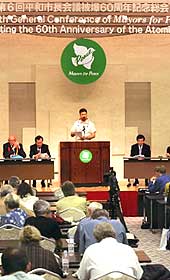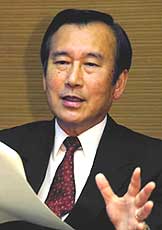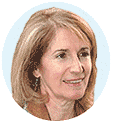Mayors for Peace, a growing alliance
1608 cities in the world, including Hiroshima
 |
In August 2005, the 6th Mayors for Peace Conference, which commemorated the 60th anniversary of the atomic bombings, was held in Hiroshima. This conference is held every four years. |
Mayors for Peace is a worldwide peace network with Hiroshima and Nagasaki at the center. In June, the group will mark its 25th anniversary. Today, there are 1608 member cities from 120 countries and regions.
Unlike countries with military forces, cities have no forces and so don't engage in war. Cities, in fact, can cross national boundaries and work together to abolish nuclear weapons.
It is estimated there are still more than 27,000 nuclear warheads in the world. The terrorist attack on September 11, 2001 has been followed by a number of serious situations, such as the Iraq War and the nuclear test conducted by North Korea. As a result, the problem of nuclear weapons is growing more worrisome.
Mayors for Peace is promoting a campaign aimed at abolishing nuclear weapons by 2020. In this issue, we examine the actions we might take, through interviews with the leader of this campaign, Mayor Tadatoshi Akiba of Hiroshima and three other mayors involved in Mayors for Peace.
Striving to abolish nuclear weapons by 2020

Mayors for Peace was founded in June 1982 by then-Mayor of Hiroshima, Takeshi Araki, with the mission of ending the threat of nuclear weapons to our world. It is registered by the United Nations as an NGO.
The office of Mayors for Peace is located in the Hiroshima Peace Culture Foundation building in Peace Memorial Park. The director, Yasuyuki Yakushiji, and his staff manage the organization.
In 2003, against the backdrop of nuclear tests in India and Pakistan as well as the American intention to develop smaller nuclear arms, Mayors for Peace began the "2020 Vision Campaign" with the goal of banning nuclear weapons. This campaign appeals for a nuclear weapons treaty by 2010 and the destruction of all nuclear weapons by 2020.
Each mayor shared their hopes for us, the next generation. And we believe, to realize the aim of abolishing nuclear weapons, that we must hold our own view of this issue and advance this campaign in our own way. (Naru Nishida, 16 )
Our membership has expanded rapidly and our goal grows in awareness
---Interview with President Tadatoshi Akiba
The Mayor of Hiroshima, Tadatoshi Akiba, won a third four-year term in the mayoral election on April 8th. He will continue in his position as President of Mayors for Peace.
 |
Mayor Akiba responds to questions from junior writers (photo taken by Yuki Sakata, 13) |
--First, could you comment on the tragic incident in which the Vice-President of Mayors for Peace, Iccho Ito, the Mayor of Nagasaki, was shot and killed during his election campaign?
I feel both deep sorrow and strong anger. I'll work hard to carry on his efforts so we can attain our target for the "2020 Vision Campaign," the abolishment of nuclear weapons by 2020.
--What is the mission of Mayors for Peace?
Mayors for Peace promotes cooperation between cities so that peace can cross national borders. When countries are in conflict, it's deplorable that their cities are held hostage as possible targets of nuclear attack. And so the cities of the world have united to oppose nuclear weapons
--What strides have been made so far?
It's notable that the number of member cities has increased at a strong pace. When I became mayor eight years ago, there were 464 member cities, but now our members total three-and-a-half times that. This means that cities recognize they have a responsibility in this matter and that they believe our aim of abolishing nuclear weapons can be realized.
--How do you plan to expand your work?
Currently, the only members from Japan are Hiroshima and Nagasaki. This is because Hiroshima and Nagasaki have traditionally conveyed the experience of the atomic bombings to the world. At this point, though, we're contemplating a change that would invite other Japanese cities in the National Council of Japan Nuclear-Free Local Authorities to join us.
--Could you tell us about yourself? What led you to this peace activity?
In 1978, while working as an associate professor in the United States, I was shocked by an American radio program called "Dropping the Atomic Bombs was Right." I pondered what I should do to change this way of thinking and I started the Akiba Project, which invited American journalists to share the true experience of Hiroshima.
--The atomic bomb survivors are now growing older and today's youth have fewer opportunities to hear their stories. How will you pass on their experience to the next generation?
My staff and I have made a list with more than 100 ideas to address this concern. We are implementing these ideas one by one, such as recording the survivors' testimonies.
--Is there something we can do to help?
Promote peace and the abolishment of nuclear weapons with as many people as you can. Share your views in your own way, such as using the internet.
--Finally, we would like to know how you learned to speak English so well!
When I was in junior high school, I made a radio and used it to listen to an English program every morning. I made some progress and then, when I studied in the United States for a year as a high school student, I got better at speaking. (Aya Nakashige, 17 Ryu Kanchika, 17)
Click the start button to listen to Mayor Akiba's talk (Japanese)
Messages from member countries
What activities are the members of Mayors for Peace involved in? We spoke with three mayors and asked them about: (1) their reason for joining Mayors for Peace (2) the interest of their citizens in Hiroshima and the atomic bomb (3) peace education (4) their expectations of the younger generation.
Here are the summaries of messages from the mayors of Malakoff, France; Hannover, Germany; and Manchester, England. (Yuki Sakata, 13)
Citizens opposing war -- Catherine Margate, the Mayor of Malakoff, France

--Why did you join Mayors for Peace?
Our city, Malakoff, is a small town on the outskirts of Paris with a population of 30,000.
Malakoff became an independent city in 1883. At that time, most of the residents were skilled labourers and workers in Paris.
Since then, French citizens have experienced a number of tragic events. In particular, World War I (1914-1918) and World War II (1939-1945) caused great damage to France and these wars were soon followed by the Indochina War and the Algerian War of Independence. After that, the United States became involved in the Vietnam War. It's dreadful, but wars like these continue today.
Whenever war breaks out, our city government and our citizens express their opposition and do what we can to promote peace. We also work with "Peace Movement," an NGO, to support the goal of abolishing nuclear weapons. And we're a member of the "Hiroshima-Nagasaki Institute" which shares the history of these two cities to the French public.
In 1990, we hosted the former mayor of Hiroshima, Mr. Araki, and we made him an honorary citizen of Marakoff. As a result of these activities, we joined Mayors for Peace. In addition, we established the Association of French Communes, Departments, and Regions for Peace (AFCDRP) and fostered a similar network of cities in France.
--How much do your citizens know about Hiroshima and the atomic bomb? How much interest do they have in these things?
Our citizens visit local exhibitions about Hiroshima and Nagasaki and they have a chance to see atomic bomb-related movies such as "Black Rain," directed by Shohei Imamura, "Riding a Crane," an animated film, and "Hiroshima Mon Amour," a famous French movie. At school and in the library, they can read the testimonies of a well-known doctor who survived the bombing and the author of the famous comic book, "Barefoot Gen." And every year, on September 21-the International Day of Peace-we hold special lectures and events related to the atomic bomb.
--How can the terror of nuclear weapons be conveyed to the children and youth of your city, when they have no experience of such weapons?
All our children have at least one opportunity to hear about the history of Hiroshima at each level of schooling-elementary school, junior high school, and high school. In addition, the city government and local peace groups conduct various activities designed for children.
--Have you visited the Atomic Bomb Dome and Peace Memorial Museum? If so, what were your impressions? Did you feel the terror of nuclear weapons?
Yes, I visited Hiroshima in 2005, the 60th anniversary of the bombing. It was an unforgettable experience and I felt very moved to share my impressions with others. Of course, I already knew a great deal about the horrific power of these weapons, but I realized this fact more deeply during my visit to Hiroshima.
--In your city, do students learn about peace in school? What is the curriculum like?
We encourage students to take an interest in both peace issues and environmental issues. In fact, in cooperation with UNESCO, we're organizing an event for next year's "International Polar Year." We don't have a separate "Peace" subject, but students have many opportunities to learn about peace through such subjects as history, geography, economics, and science.
--What do you think young people in Hiroshima can do to promote peace?
The youth of Hiroshima can contribute to peace by taking over Hiroshima's history and treasuring the A-bomb Dome.
They can also be guides for foreign visitors and support groups that are involved in peace activities.
It would be a good idea, too, to continue creating new peace-related materials, such as DVDs, comic books, and movies.
For instance, in March 2003, we hosted a group of young musicians from Hiroshima. They were marimba players. They held a concert tour in France and shared their message of peace through music. I hope this sort of international peace exchange can increase in the future.
|
Preserving the experience of the bombing -- Stephan Weil, the Mayor of Hannover, Germany 
--Why did you decide to participate in Mayors for Peace? Hannover and Hiroshima have been joined in a city twinning partnership since 1983,and there have been friendly relations between our cities for almost forty years now. As Lord Mayor of Hannover I regard it as my special duty to work with Hiroshima, Nagasaki and many other cities for the abolition of nuclear weapons, and for peace in the world. --How much do your citizens know about the atomic bomb and Hiroshima? Every year in Hannover, we think about the atom bomb and the terrible things that happened in Hiroshima over 6 decades ago, especially on 6th August, Hiroshima Day when, like you, we remember the victims of the atomic bomb in a public ceremony and appeal for nuclear disarmament to the politicians responsible. --How much interest do they have? Of course, people are more immediately concerned with their day-to-day situations and problems-financial and economic worries or whether their job is secure-than with the threat to the world from stockpiles of nuclear weapons. This is why it's important for people who know how serious the threat is to keep bringing it to the public attention. --Have you ever seen the Atomic Bomb Dome or the Hiroshima Peace Memorial museum? If you have, what was your impression? Did you feel the terror of nuclear weapons? I haven't yet been to Hiroshima, and so I only know these symbols from television reports. But I do know what menace and terror nuclear weapons can cause, and what war means. Like many German cities, Hannover was almost completely destroyed in the Second World War, and I heard how terrible this war was from my parents and grandparents. This is why I work in 'Mayors for peace' to try and prevent something like this from ever happening again. --How can you tell the terror of nuclear weapons to the elementary, junior high or high school students in your city who have never suffered such weapons? In recent years we've frequently staged exhibitions with photographs, drawings and objects, and film and video showings, to tell people about the extent of the terrible events of 6th August 1945 in Hiroshima. Hibakusha have been our guests in Hannover many times, to talk to school students about their harrowing experiences. In this way it's been possible -as I've heard from the students and teachers themselves -to give especially younger people a vivid picture of what happened. We also make our stock of exhibitions and media available to schools for their own events. --In your city, do students learn about peace at elementary or junior high or high school? If they do, how many hours does it take to finish the curriculum? What does the curriculum include? The school curricula and the teaching syllabi do not set separate topics on 'Hiroshima','atomic Bombs', or 'Working for Peace', so it depends on the personal commitment of the respective teacher or the interests of the students, how these themes are addressed in school and how much time is devoted to them in lessons. As one of Hiroshima's twin cities, of course, we make efforts to ensure that teachers in Hannover schools see it as natural to present these topics, and we support them with appropriate information materials. --What do you think young people living in Hiroshima can do for peace? It's a question of how long it will still be possible for the victims of the atomic bombs to tell their own stories and to speak of their wish for a world free of nuclear weapons. The extent to which their wish can be fulfilled in future will depend on whether young people take up their cause and carry on the campaign. In this respect the young people of Hiroshima, as 'Ambassadors' of their city, have a very special importance to the world. |
Working together in a global network
-- David Sandiford, the Mayor of Manchester, England
--Why did you decide to participate in Mayors for Peace?
Manchester joined Mayors for Peace in 1985. It was already involved in developing the international Nuclear Free Zones movement. At the time the threat of nuclear war in Europe was very real. Over the last 2 decades the threat in Europe has receded but worldwide the danger of nuclear weapons use remains. Manchester continues both its work with Mayors for Peace and Nuclear Free Local Authorities to campaign for peace and a nuclear free world.
--How much do your citizens know about the atomic bomb and Hiroshima?
Manchester has organized A bomb exhibitions and produced public information materials. The City Council provides support to citizens campaigning for nuclear weapons abolition. However, peace work has suffered funding cuts (as has local government generally) and we are not doing as much now to communicate anti nuclear and Mayors for Peace work to the public. Information about Manchester's support for Mayors for Peace can be found on the City Council website: www.manchester.gov.uk
--How much interest do they have?
The level of interest is lower now than twenty years ago. People read and hear about nuclear threats but they do not believe it affects them. National organizations like CND are still very active and have experienced a revival in recent years, but not to the level of the early 1980s. Right now there is much more public concern about the war in Iraq.
-- Have you ever seen the Atomic Bomb Dome or the Hiroshima Peace Memorial museum? If you have, what was your impression?
Yes, I have seen the A Bomb Dome and visited Hiroshima Peace Museum (and Nagasaki Peace Museum). You cannot fail to be moved by the experience. Everyone I know who visits Hiroshima or Nagasaki returns pledging to work for nuclear weapons abolition.
--Did you feel the terror of nuclear weapons?
Yes, the full horror of nuclear weapons effects is graphically displayed - but I found the actual physical experience of standing at ground zero and trying to imagine the terrible pain and suffering inflicted in those split seconds of 6 August and 9 August 1945 most disturbing.
--How can you tell the terror of nuclear weapons to the elementary, junior high or high school students in your city who have never suffered such weapons?
I do not think any local Council is doing enough to teach about the horrors of Hiroshima and Nagasaki despite some good work here in Manchester and other Cities like London, Glasgow, Leeds and Coventry. In recent years we have circulated information material to schools and school parties have visited exhibitions about the A Bomb here in Manchester Town Hall. However, resources are very limited and school teachers are under huge pressure from their workloads. Teachers do not want to add to their workloads and this is understandable. What might be useful is a section of the Mayors for Peace website devoted to schools information materials. Then it would be possible to draw teaching staff attention to the website for materials that can support class room discussions and projects.
-- In your city, do students learn about peace at elementary or junior high or high school? If they do, how many hours does it take to finish the curriculum?
There is no 'peace' curriculum as such in the national school curriculum - but students at all levels learn about conflict resolution and how to manage conflict without violence at all levels from the personal to the international. Unfortunately students are surrounded by many bad examples in society as well as good examples.
--What do you think young people living in Hiroshima can do for peace?
Young people in Hiroshima should encourage their City Council to continue its internationally respected peace work. More direct school to school links, and pupil to pupil links, internationally would be excellent, so we can increase international cultural understanding and develop awareness about the need to work cooperatively and change our priorities by, for example, spending much less on military budgets and much more on protecting the environment, tackling climate change, and removing the causes of conflict.
- National Council of Japan Nuclear-Free Local Authorities
A network of local governments who have declared their cities "nuclear-free zones." Founded in August 1984, as of April 1st, 2007 it numbers 228 members. They are engaged in sharing information about peace events and holding the atomic bomb exhibition tour. The mayor of Nagasaki serves as the president, and the five vice-presidents include the mayors of Hiroshima and Hatsukaichi.
- Akiba Project
A project that invited American journalists to Hiroshima and Nagasaki in order to share the reality of the atomic bomb with their readership in the United States. Mayor Akiba conceived this idea while teaching at a university in the United States and the Hiroshima International Cultural Foundation carried it out. From 1979, over a period of 10 years, a total of 34 journalists visited Hiroshima and Nagasaki.
